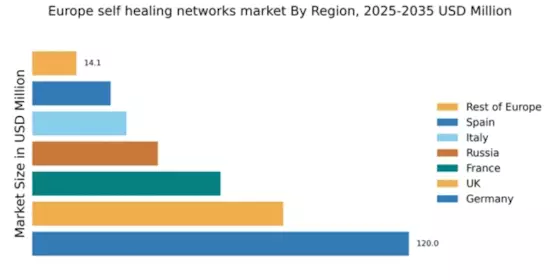Advancements in IoT Integration
The integration of Internet of Things (IoT) devices is significantly influencing the self healing-networks market in Europe. With the proliferation of IoT applications across various sectors, the complexity of network management has increased. Self healing networks offer a solution by enabling automated responses to network anomalies, which is crucial for maintaining optimal performance. The self healing-networks market is projected to grow as organizations adopt these technologies to manage the vast amounts of data generated by IoT devices. It is estimated that by 2026, the number of connected IoT devices in Europe will exceed 30 billion, further driving the need for self healing capabilities to ensure network resilience and efficiency.
Supportive Government Initiatives
Government initiatives aimed at fostering innovation and technological advancement are playing a crucial role in the self healing-networks market in Europe. Various European governments are investing in research and development programs that promote the adoption of self healing technologies. These initiatives often include funding opportunities and incentives for businesses to integrate advanced network solutions. The self healing-networks market stands to benefit from these supportive measures, as they encourage organizations to explore innovative approaches to network management. As a result, the market is likely to expand, driven by a favorable regulatory environment that prioritizes technological progress and resilience in network infrastructures.
Growing Demand for Network Reliability
The self healing-networks market in Europe is experiencing a surge in demand for enhanced network reliability. As businesses increasingly rely on uninterrupted connectivity, the need for self healing capabilities becomes paramount. This trend is driven by the rising costs associated with network downtime, which can reach up to €300,000 per hour for large enterprises. Consequently, organizations are investing in self healing technologies to minimize disruptions and ensure seamless operations. The self healing-networks market is thus positioned to benefit from this growing emphasis on reliability, as companies seek solutions that can autonomously detect and rectify issues, thereby reducing the need for manual intervention and enhancing overall efficiency.
Rising Cyber Threats and Security Concerns
The escalating threat of cyberattacks is a major driver for the self healing-networks market in Europe. As organizations face increasingly sophisticated cyber threats, the need for resilient network infrastructures becomes essential. Self healing networks can autonomously respond to security breaches, thereby minimizing potential damage and ensuring data integrity. The self healing-networks market is expected to grow as businesses seek solutions that not only enhance operational efficiency but also bolster security measures. With cybercrime projected to cost European businesses over €1 trillion annually by 2025, the urgency for self healing technologies that can mitigate these risks is more pronounced than ever.
Increased Focus on Operational Cost Reduction
In the current economic climate, organizations in Europe are prioritizing operational cost reduction, which is positively impacting the self healing-networks market. By implementing self healing technologies, companies can significantly lower maintenance costs associated with network management. Studies indicate that businesses can save up to 25% on operational expenses by automating network recovery processes. This trend is particularly relevant in sectors such as telecommunications and manufacturing, where network reliability is critical. The self healing-networks market is thus likely to see increased adoption as organizations recognize the financial benefits of investing in self healing solutions that enhance efficiency while reducing costs.


















Leave a Comment